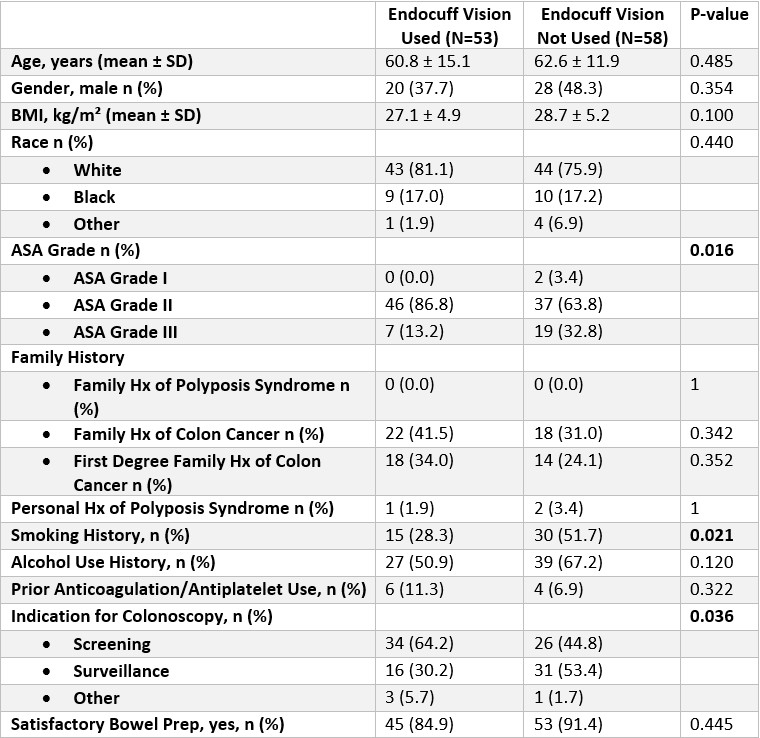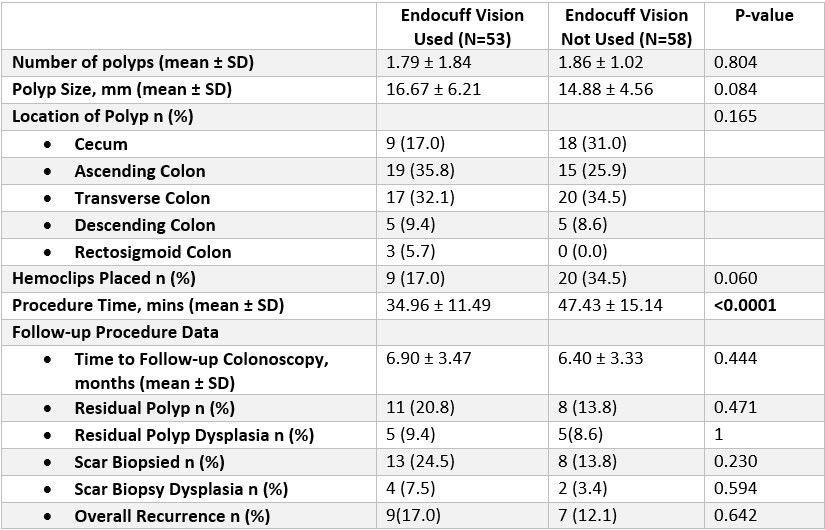Monday Poster Session
Category: General Endoscopy
P2999 - Clearer View, Quicker Resection: Assessing the Role of Endocuff Vision in Endoscopic Mucosal Resection (EMR)
Monday, October 27, 2025
10:30 AM - 4:00 PM PDT
Location: Exhibit Hall

Muhammad Saad Faisal, MD (he/him/his)
Henry Ford Health
Detroit, MI
Presenting Author(s)
Muhammad Saad Faisal, MD1, Josiah Tang, BSc2, Haziq Latif-Jangda, BSc3, Bradley Karmo, MD4, Minahil Fatima, MD1, Neal Doshi, MD1, Keith E. Mullins, MD1, Suraj Suresh, MD1
1Henry Ford Health, Detroit, MI; 2Michigan State University College of Osteopathic Medicine, Detroit, MI; 3Wayne State University School of Medicine, Detroit, MI; 4Henry Ford Health, West Bloomfield, MI
Introduction: Endocuff Vision (EV) is a distal colonoscope attachment designed to enhance mucosal visualization and scope stability. Its impact on Endoscopic Mucosal Resection (EMR) outcomes, particularly regarding recurrence, visualization, and procedural efficiency, remains underexplored. By improving exposure of the colonic mucosa, the EV may facilitate more complete polyp resection, potentially reducing the rates of recurrence. This study evaluates EMR outcomes performed with versus without EV assistance.
Methods: We conducted a retrospective case-control study of patients who underwent cold-snare EMR at a tertiary academic center between January 2023 and December 2024. Resected polyps were divided into two groups: those removed with use of the EV (case group) and those without (control group). Demographics, polyp characteristics, procedural details, and follow-up outcomes were compared. Continuous variables were analyzed using t-tests and categorical variables using Chi-square tests.
Results: A total of 111 polyps were removed from 84 patients using cold-snare EMR. Of these, 53 (47.7%) were resected with EV assistance and 58 (52.3%) without. The groups were similar in age, sex, and race. The EV group had fewer ASA grade 3 patients (13.2% vs. 32.8%, p=0.016) and a lower prevalence of smoking (28.3% vs. 51.7%, p=0.021). There were no significant differences in the mean number of polyps removed (1.79 vs. 1.86, p=0.804), polyp size (16.7 mm vs. 14.9 mm, p=0.084), and location. Procedures performed with EV had a significantly shorter duration compared to those without (34.96 ± 11.49 vs. 47.43 ± 15.14 minutes, p < 0.001). There was also a trend toward reduced prophylactic clip usage in the EV group (17.0% vs. 34.5%, p=0.060). No significant differences were observed in recurrence rates (17.0% vs. 12.1%, p=0.642) and follow-up intervals were similar (6.9 vs. 6.4 months, p=0.444) between the two groups.
Discussion: EMR performed with EV is safe and achieves clinical outcomes comparable to standard EMR. Notably, EV use was associated with a significantly shorter procedure duration, suggesting improved efficiency related to mucosal visualization and scope control. A trend toward reduced prophylactic clip use was also observed. However, recurrence rates and other clinical outcomes remained similar between groups. Larger prospective studies are warranted to assess whether the procedural advantages of EV translate to improved long-term outcomes.

Figure: Table 1. Patient Baseline Demographics

Figure: Table 2. Procedural Details and Outcomes
Disclosures:
Muhammad Saad Faisal indicated no relevant financial relationships.
Josiah Tang indicated no relevant financial relationships.
Haziq Latif-Jangda indicated no relevant financial relationships.
Bradley Karmo indicated no relevant financial relationships.
Minahil Fatima indicated no relevant financial relationships.
Neal Doshi indicated no relevant financial relationships.
Keith E. Mullins indicated no relevant financial relationships.
Suraj Suresh indicated no relevant financial relationships.
Muhammad Saad Faisal, MD1, Josiah Tang, BSc2, Haziq Latif-Jangda, BSc3, Bradley Karmo, MD4, Minahil Fatima, MD1, Neal Doshi, MD1, Keith E. Mullins, MD1, Suraj Suresh, MD1. P2999 - Clearer View, Quicker Resection: Assessing the Role of Endocuff Vision in Endoscopic Mucosal Resection (EMR), ACG 2025 Annual Scientific Meeting Abstracts. Phoenix, AZ: American College of Gastroenterology.
1Henry Ford Health, Detroit, MI; 2Michigan State University College of Osteopathic Medicine, Detroit, MI; 3Wayne State University School of Medicine, Detroit, MI; 4Henry Ford Health, West Bloomfield, MI
Introduction: Endocuff Vision (EV) is a distal colonoscope attachment designed to enhance mucosal visualization and scope stability. Its impact on Endoscopic Mucosal Resection (EMR) outcomes, particularly regarding recurrence, visualization, and procedural efficiency, remains underexplored. By improving exposure of the colonic mucosa, the EV may facilitate more complete polyp resection, potentially reducing the rates of recurrence. This study evaluates EMR outcomes performed with versus without EV assistance.
Methods: We conducted a retrospective case-control study of patients who underwent cold-snare EMR at a tertiary academic center between January 2023 and December 2024. Resected polyps were divided into two groups: those removed with use of the EV (case group) and those without (control group). Demographics, polyp characteristics, procedural details, and follow-up outcomes were compared. Continuous variables were analyzed using t-tests and categorical variables using Chi-square tests.
Results: A total of 111 polyps were removed from 84 patients using cold-snare EMR. Of these, 53 (47.7%) were resected with EV assistance and 58 (52.3%) without. The groups were similar in age, sex, and race. The EV group had fewer ASA grade 3 patients (13.2% vs. 32.8%, p=0.016) and a lower prevalence of smoking (28.3% vs. 51.7%, p=0.021). There were no significant differences in the mean number of polyps removed (1.79 vs. 1.86, p=0.804), polyp size (16.7 mm vs. 14.9 mm, p=0.084), and location. Procedures performed with EV had a significantly shorter duration compared to those without (34.96 ± 11.49 vs. 47.43 ± 15.14 minutes, p < 0.001). There was also a trend toward reduced prophylactic clip usage in the EV group (17.0% vs. 34.5%, p=0.060). No significant differences were observed in recurrence rates (17.0% vs. 12.1%, p=0.642) and follow-up intervals were similar (6.9 vs. 6.4 months, p=0.444) between the two groups.
Discussion: EMR performed with EV is safe and achieves clinical outcomes comparable to standard EMR. Notably, EV use was associated with a significantly shorter procedure duration, suggesting improved efficiency related to mucosal visualization and scope control. A trend toward reduced prophylactic clip use was also observed. However, recurrence rates and other clinical outcomes remained similar between groups. Larger prospective studies are warranted to assess whether the procedural advantages of EV translate to improved long-term outcomes.

Figure: Table 1. Patient Baseline Demographics

Figure: Table 2. Procedural Details and Outcomes
Disclosures:
Muhammad Saad Faisal indicated no relevant financial relationships.
Josiah Tang indicated no relevant financial relationships.
Haziq Latif-Jangda indicated no relevant financial relationships.
Bradley Karmo indicated no relevant financial relationships.
Minahil Fatima indicated no relevant financial relationships.
Neal Doshi indicated no relevant financial relationships.
Keith E. Mullins indicated no relevant financial relationships.
Suraj Suresh indicated no relevant financial relationships.
Muhammad Saad Faisal, MD1, Josiah Tang, BSc2, Haziq Latif-Jangda, BSc3, Bradley Karmo, MD4, Minahil Fatima, MD1, Neal Doshi, MD1, Keith E. Mullins, MD1, Suraj Suresh, MD1. P2999 - Clearer View, Quicker Resection: Assessing the Role of Endocuff Vision in Endoscopic Mucosal Resection (EMR), ACG 2025 Annual Scientific Meeting Abstracts. Phoenix, AZ: American College of Gastroenterology.
